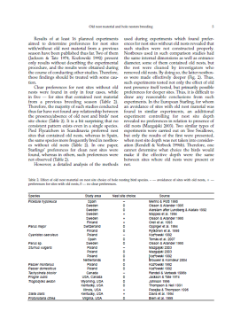- Search in all Repository
- Literature and maps
- Archeology
- Mills database
- Natural sciences
Advanced search
Advanced search
Advanced search
Advanced search
Advanced search

Object
Title: How Urban Kestrels Falco tinnunculus Divide Their Hunting Grounds: Partitioning or Cohabitation?
Creator:
Riegert, Jan ; Fainová, Drahomíra ; Mikeš, Václav ; Fuchs, Roman
Date issued/created:
Resource type:
Subtitle:
Sposób użytkowania terenów łowieckich przez miejskie pustułki w Czeskich Budziejowicach ; Hunting ranges of urban Kestrels
Contributor:
Museum and Institute of Zoology, Polish Academy of Sciences
Publisher:
Museum and Institute of Zoology, Polish Academy of Sciences ; Natura Optima Dux Foundation
Place of publishing:
Description:
Type of object:
Abstract:
The hunting ranges of 34 male urban Kestrels were studied in a small city (40 km2) in S Bohemia (Czech Republic). It was assumed that males from the city center and periphery hunt for voles mainly on the city's outskirts. The “city-center” males are unable to defend their hunting ranges on the periphery because of aggression on the part of the “periphery” Kestrels. To counter this, they may either 1) invade the hunting ranges of periphery males or 2) establish their own exclusive hunting ranges. Our data supported the first suggestion. Hunting range size varied greatly, from 0.8 to 25.0 km2 (7.2 ± 6.9 km2), with large overlaps of between 0.3% and 51.4% (12.5 ± 11.6%). The ranges of city-center males were several times larger than those of the periphery males, and greatly overlapped the ranges of other city center and periphery males. Overlapping of the hunting ranges of periphery males was less extensive. The higher energy costs in terms of flying to distant suitable hunting areas and frequent changes of hunting grounds should decrease the preference for nesting in the city center. Therefore, we suggest that Kestrels derive other advantages from living in the city center (e.g., the high quality of nest sites). Cohabitation, whereby city center males invade the hunting grounds of periphery males, appears to be a more effective strategy than partitioning.
Relation:
Volume:
Issue:
Start page:
End page:
Detailed Resource Type:
Format:
Resource Identifier:
oai:rcin.org.pl:55635 ; 10.3161/068.042.0101
Source:
MiIZ PAN, sygn. P.4568 ; MiIZ PAN, sygn. P.257 ; click here to follow the link
Language:
Language of abstract:
Rights:
Prawa zastrzeżone - dostęp nieograniczony
Terms of use:
Digitizing institution:
Muzeum i Instytut Zoologii Polskiej Akademii Nauk
Original in:
Biblioteka Muzeum i Instytutu Zoologii PAN
Access:
Object collections:
- Digital Repository of Scientific Institutes > Partners' collections > Museum and Institute of Zoology PAS > Scientific Journals
- Digital Repository of Scientific Institutes > Partners' collections > Museum and Institute of Zoology PAS > MIZ PAN Publications > Acta Ornithologica
- Digital Repository of Scientific Institutes > Literature > Journals/Articles
Last modified:
Oct 2, 2020
In our library since:
Jul 29, 2015
Number of object content downloads / hits:
36
All available object's versions:
https://rcin.org.pl./publication/75715
Show description in RDF format:
Show description in RDFa format:
Show description in OAI-PMH format:
Objects Similar
Żmihorski, Michał Rejt, Łukasz
Salvati, Luca Manganaro, Alberto Fattorini, Simone Piattella, Emanuele
Rejt, Łukasz Turlejski, Krzysztof Bronche, Krzysztof Topczewski, Andrzej M.
Padilla, David P Nogales, Manuel Marrero, Patricia
Najbar, Bartłomiej

 INSTYTUT ARCHEOLOGII I ETNOLOGII POLSKIEJ AKADEMII NAUK
INSTYTUT ARCHEOLOGII I ETNOLOGII POLSKIEJ AKADEMII NAUK
 INSTYTUT BADAŃ LITERACKICH POLSKIEJ AKADEMII NAUK
INSTYTUT BADAŃ LITERACKICH POLSKIEJ AKADEMII NAUK
 INSTYTUT BADAWCZY LEŚNICTWA
INSTYTUT BADAWCZY LEŚNICTWA
 INSTYTUT BIOLOGII DOŚWIADCZALNEJ IM. MARCELEGO NENCKIEGO POLSKIEJ AKADEMII NAUK
INSTYTUT BIOLOGII DOŚWIADCZALNEJ IM. MARCELEGO NENCKIEGO POLSKIEJ AKADEMII NAUK
 INSTYTUT BIOLOGII SSAKÓW POLSKIEJ AKADEMII NAUK
INSTYTUT BIOLOGII SSAKÓW POLSKIEJ AKADEMII NAUK
 INSTYTUT CHEMII FIZYCZNEJ PAN
INSTYTUT CHEMII FIZYCZNEJ PAN
 INSTYTUT CHEMII ORGANICZNEJ PAN
INSTYTUT CHEMII ORGANICZNEJ PAN
 INSTYTUT FILOZOFII I SOCJOLOGII PAN
INSTYTUT FILOZOFII I SOCJOLOGII PAN
 INSTYTUT GEOGRAFII I PRZESTRZENNEGO ZAGOSPODAROWANIA PAN
INSTYTUT GEOGRAFII I PRZESTRZENNEGO ZAGOSPODAROWANIA PAN
 INSTYTUT HISTORII im. TADEUSZA MANTEUFFLA POLSKIEJ AKADEMII NAUK
INSTYTUT HISTORII im. TADEUSZA MANTEUFFLA POLSKIEJ AKADEMII NAUK
 INSTYTUT JĘZYKA POLSKIEGO POLSKIEJ AKADEMII NAUK
INSTYTUT JĘZYKA POLSKIEGO POLSKIEJ AKADEMII NAUK
 INSTYTUT MATEMATYCZNY PAN
INSTYTUT MATEMATYCZNY PAN
 INSTYTUT MEDYCYNY DOŚWIADCZALNEJ I KLINICZNEJ IM.MIROSŁAWA MOSSAKOWSKIEGO POLSKIEJ AKADEMII NAUK
INSTYTUT MEDYCYNY DOŚWIADCZALNEJ I KLINICZNEJ IM.MIROSŁAWA MOSSAKOWSKIEGO POLSKIEJ AKADEMII NAUK
 INSTYTUT PODSTAWOWYCH PROBLEMÓW TECHNIKI PAN
INSTYTUT PODSTAWOWYCH PROBLEMÓW TECHNIKI PAN
 INSTYTUT SLAWISTYKI PAN
INSTYTUT SLAWISTYKI PAN
 SIEĆ BADAWCZA ŁUKASIEWICZ - INSTYTUT TECHNOLOGII MATERIAŁÓW ELEKTRONICZNYCH
SIEĆ BADAWCZA ŁUKASIEWICZ - INSTYTUT TECHNOLOGII MATERIAŁÓW ELEKTRONICZNYCH
 MUZEUM I INSTYTUT ZOOLOGII POLSKIEJ AKADEMII NAUK
MUZEUM I INSTYTUT ZOOLOGII POLSKIEJ AKADEMII NAUK
 INSTYTUT BADAŃ SYSTEMOWYCH PAN
INSTYTUT BADAŃ SYSTEMOWYCH PAN
 INSTYTUT BOTANIKI IM. WŁADYSŁAWA SZAFERA POLSKIEJ AKADEMII NAUK
INSTYTUT BOTANIKI IM. WŁADYSŁAWA SZAFERA POLSKIEJ AKADEMII NAUK


































